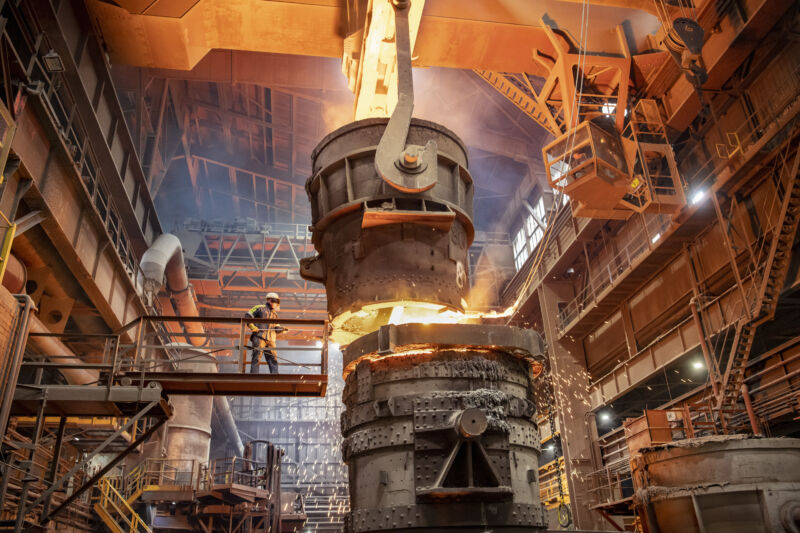
Monty Rakusen/Getty
lin the city of Woburn, Massachusetts, a suburb just north of Boston, a cadre of engineers and scientists in white coats inspected an orderly stack of brick-sized, gunmetal-gray steel blocks on a desk in a neon-lit lab space.
What they looked at was a batch of steel made using an innovative manufacturing method, one that Boston Metal, a company that emerged from MIT a decade ago, hopes to dramatically change the way the alloy has been made for centuries. By using electricity to separate iron from its ore, the company claims it can make steel without releasing carbon dioxide, providing a path to clearing one of the world’s worst industries for greenhouse gas emissions.
Steel is an essential input for engineering and construction and is one of the most popular industrial materials in the world, with an annual production of more than 2 billion tons. However, this abundance comes at a high cost to the environment. Steel production is responsible for 7 to 11 percent of global greenhouse gas emissions, making it one of the largest industrial sources of air pollution. And because production could increase by a third by 2050, this environmental burden could increase.
This poses a major challenge for tackling the climate crisis. The United Nations says significantly reducing industrial carbon emissions is essential to keep global warming below 1.5° Celsius set in the 2015 Paris climate agreement. and other heavy industries fall by 93 percent by 2050, according to estimates from the International Energy Agency.
Faced with increasing pressure from governments and investors to cut emissions, a number of steel makers, including both large producers and startups, are experimenting with low-carbon technologies that use hydrogen or electricity instead of traditional carbon-intensive production. Some of these efforts are approaching commercial reality.
“We’re talking about a capital-intensive, risk-averse industry where disruption is extremely rare,” said Chris Bataille, an energy economist at IDDRI, a Paris-based research think tank. That’s why he added: “It’s exciting” that so much is happening at once.
Still, experts agree that transforming a global industry that exceeded $2.5 trillion in 2017 and employs more than 6 million people will require tremendous effort. Aside from the practical obstacles to scaling up new processes in a timely manner to meet global climate goals, there are concerns about China, which produces more than half of the world’s steel and whose plans to decarbonize the steel sector remain vague.
“It is certainly not an easy solution to decarbonise an industry like this,” Bataille says. ‘But there is no choice. The future of the sector – and that of our climate – depends on it.”
Modern steel production includes: different production phases. Typically, iron ore is crushed and converted into sinter (a crude solid) or pellets. Separately, coal is fired and converted into coke. The ore and coke are then mixed with limestone and fed to a large blast furnace where a stream of extremely hot air is introduced from the bottom. At high temperatures, the coke burns and liquid iron is formed, also known as pig iron or blast furnace iron. The molten material then goes into an oxygen furnace, where it is blasted with pure oxygen through a water-cooled lance, which forces carbon to leave raw steel as the final product.
This method, first patented by English engineer Henry Bessemer in the 1850s, produces carbon dioxide emissions in several ways. First, the chemical reactions in the blast furnace result in emissions, because carbon contained in coke and limestone bonds with oxygen in the air to create carbon dioxide as a byproduct. In addition, fossil fuels are typically burned to heat the blast furnace and to power sinter and pellet plants, as well as coke ovens, emitting carbon dioxide in the process.
As much as 70 percent of the world’s steel is produced in this way, generating nearly two tons of carbon dioxide for every ton of steel produced. The remaining 30 percent is almost all made by electric arc furnaces, which use an electric current to melt steel – largely recycled scrap – and have much lower CO₂ emissions than blast furnaces.
But because of the limited supply of scrap, not all future demand can be met this way, said Jeffrey Rissman, director of the industry program and head of modeling at San Francisco-based energy and climate policy firm Energy Innovation. With the right policies, recycling could supply up to 45 percent of global demand by 2050, he said. “The rest is met by forging primary ore-based steel, which is where most of the emissions come from.”
So, “if the steel industry is serious” about its climate commitments, he added, “it will have to fundamentally reshape the way the material is made — and do so pretty quickly.”

